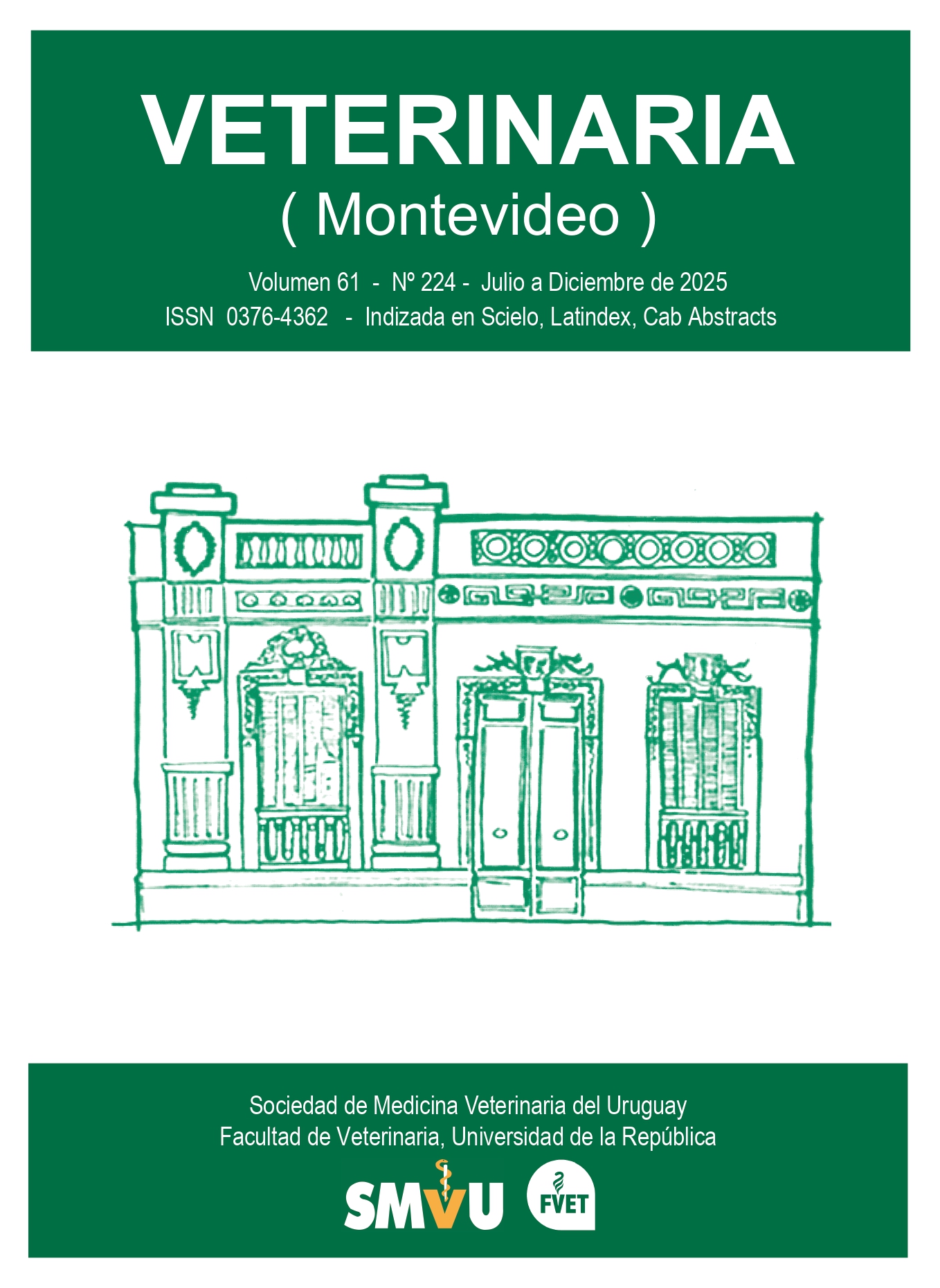Disfunção da pars intermedia da hipófise
Estudo de caso
DOI:
https://doi.org/10.29155/VET.61.224.1Palavras-chave:
Equino, Cushing, Hipertricose, HipófiseResumo
A disfunção da pars intermedia da hipófise (PPID, pituitary pars intermedia dysfunction) é um distúrbio endócrino que ocorre principalmente em equinos idosos, sem outra predisposição clara. Os principais sinais clínicos são a hipertricose, letargia, laminite e perda de peso e massa muscular. O seu impacto econômico reside sobretudo nos casos subclínicos que passam despercebidos, causando diminuição do desempenho, falhas reprodutivas e gastos em cuidados médicos e tratamentos, que visam resolver apenas estes aspectos. É uma patologia subdiagnosticada no Uruguai e sem tratamento disponível. O objetivo deste trabalho é reportar o primeiro caso clínico com diagnóstico definitivo de PPID em um equino no país.
Downloads
Métricas
Referências
Aleman, M., Watson, J. L., Williams, D. C., LeCouteur, R. A., Nieto, J. E., & Shelton, G. D. (2006). Myopathy in horses with pituitary pars intermedia dysfunction (Cushing’s disease). Neuromuscular Disorders, 16, 737-744. https://doi.org/10.1016/j.nmd.2006.07.019
Barrell, E. A. (2022). Polyuria and Polydipsia in Horses. Veterinary Clinics of North America: Equine Practice, 38, 95-108. https://doi.org/10.1016/j.cveq.2021.11.007
Beech, J., Boston, R., & Lindborg, S. (2011). Comparison of cortisol and ACTH responses after administration of thyrotropin releasing hormone in normal horses and those with pituitary pars intermedia dysfunction. Journal of Veterinary Internal Medicine, 25, 1431-1438. https://doi.org/10.1111/j.1939-1676.2011.00810.x
Bennaim, M., Shiel, R. E., & Mooney, C. T. (2019). Diagnosis of spontaneous hyperadrenocorticism in dogs. Part 1: Pathophysiology, aetiology, clinical and clinicopathological features. The Veterinary Journal, 252, 105342. https://doi.org/10.1016/j.tvjl.2019.105342
Bertin, F., & Fraser, N. (2020). Equine Endocrinology. Severn.
Cabrera Blatter, M. F., del Prado, A., Gallelli, M. F., D’Anna, E., Ivanic, J., Esarte, M., Miceli, D. D., Gómez, N. V., & Castillo, V. A. (2012). Blindness in dogs with pituitary dependent hyperadrenocorticism: Relationship with glucose, cortisol and triglyceride concentration and with ophthalmic blood flow. Research in Veterinary Science, 92(3), 387-392. https://doi.org/10.1016/j.rvsc.2011.04.017
Hart, K., Durham, A., Frank, N., McGowan, C., Schott, H., & Stewart, A.J. (2021). Recommendations on diagnosis and management of pituitary pars intermedia dysfunction (PPID). Equine Endocrinology Group. https://idppid.com/sites/default/files/2021%20EEG%20PPID%20Recommendations%20%281%29.pdf
Heinrichs, M., Baumgärtner, W., & Capen, C. C. (1990). Immunocytochemical demonstration of proopiomelanocortin-derived peptides in pituitary adenomas of the pars intermedia in horses. Veterinary Pathology, 27(6), 419-425. https://doi.org/10.1177/030098589902700606
Henneke, D. R., Potter, G. D., Kreider, J. L., & Yeates, B.F. (1983). Relationship between condition score, physical measurements and body fat percentage in mares. Equine Veterinary Journal, 15, 371-372. https://doi.org/10.1111/j.2042-3306.1983.tb01826.x
Horn, R., Bamford, N. J., Afonso, T., Sutherland, M., Buckerfield, J., Tan, R. H. H., Secombe, C. J., Stewart, A. J., & Bertin, F. R. (2019). Factors associated with survival, laminitis and insulin dysregulation in horses diagnosed with equine pituitary pars intermedia dysfunction. Equine Veterinary Journal, 51(4), 440-445. https://doi.org/10.1111/evj.13041
Horn, R., Stewart, A., Jackson, K., Dryburgh, E., Medina-Torres, C., & Bertin, F. (2021). Clinical implications of using adrenocorticotropic hormone diagnostic cutoffs or reference intervals to diagnose pituitary pars intermedia dysfunction in mature horses. Journal of Veterinary Internal Medicine, 35(1), 560-570. https://doi.org/10.1111/jvim.16017
Huang, L., Palmieri, C., & Bertin, F. R. (2022). Correlation of pituitary histomorphometry with dopamine and dopamine D2 receptor expression in horses with pituitary pars intermedia dysfunction. Research in Veterinary Science, 152, 427-433. https://doi.org/10.1016/j.rvsc.2022.08.018
Innerå, M., Petersen, A. D., Desjardins, D. R., Steficek, B. A., Rosser, E. J., Jr., & Schott, H. C., II. (2013). Comparison of hair follicle histology between horses with pituitary pars intermedia dysfunction and excessive hair growth and normal aged horses. Veterinary Dermatology, 24(1), 212–e47. https://doi.org/10.1111/j.1365-3164.2012.01080.x
Ireland, J., & McGowan, C. (2018). Epidemiology of pituitary pars intermedia dysfunction: A systematic literature review of clinical presentation, disease prevalence and risk factors. The Veterinary Journal, 235, 22-33. https://doi.org/10.1016/j.tvjl.2018.03.002
Kam, Y. N., McKenzie, K., Coyle, M., & Bertin, F. R. (2021). Repeatability of a thyrotropin-releasing hormone stimulation test for diagnosis of pituitary pars intermedia dysfunction in mature horses. Journal of Veterinary Internal Medicine, 35(6), 2885-2890. https://doi.org/10.1111/jvim.16281
Keen, J. A., McLaren, M., Chandler, K. J., & McGorum, B. C. (2004). Biochemical indices of vascular function, glucose metabolism and oxidative stress in horses with equine Cushing’s disease. Equine Veterinary Journal, 36(3), 226-229. https://doi.org/10.2746/0425164044877215
Kirkwood, N., Hughes, K., & Stewart, A. (2022). Pituitary pars intermedia dysfunction (PPID) in horses. Veterinary Sciences, 9(10), 556. https://doi.org/10.3390/vetsci9100556
Li, F. I., Spence, R. J., de Laat, M. A., Harris, P. A., Sonntag, J., Menzies-Gow, N. J., Durham, A. E., Bailey, S. R., & Sillence, M. N. (2023). Association between insulin dysregulation and adrenocorticotropic hormone in aged horses and ponies with no clinical signs of pituitary pars intermedia dysfunction. Equine Veterinary Journal, 55(6), 1003-1011. https://doi.org/10.1111/evj.13925
McFarlane, D. (2011). Equine pituitary pars intermedia dysfunction. Veterinary Clinics of North America: Equine Practice, 27, 93-113. https://doi.org/10.1016/j.cveq.2010.12.007
McFarlane, D. (2014). Pathophysiology and clinical features of pituitary pars intermedia dysfunction. Equine Veterinary Education, 26(11), 592-598. https://doi.org/10.1111/eve.12237
McFarlane, D., Dybdal, N., Donaldson, M. T., Miller, L., & Cribb, A. E. (2005). Nitration and increased alpha-synuclein expression associated with dopaminergic neurodegeneration in equine pituitary pars intermedia dysfunction. Journal of Neuroendocrinology, 17(2), 73-80. https://doi.org/10.1111/j.1365-2826.2005.01277.x
McFarlane, D., Hale, G. M., Johnson, E. M., & Maxwell, L. K. (2010). Fecal egg counts after anthelmintic administration to aged horses and horses with pituitary pars intermedia dysfunction. Journal of the American Veterinary Medical Association, 236(3), 330-334. https://doi.org/10.2460/javma.236.3.330
McGowan, T. W., Pinchbeck, G. P., & McGowan, C. M. (2013). Prevalence, risk factors and clinical signs predictive for equine pituitary pars intermedia dysfunction in aged horses. Equine Veterinary Journal, 45(1), 74-79. https://doi.org/10.1111/j.2042-3306.2012.00578.x
Meyer, J. C., Hunyadi, L. M., & Ordóñez-Mena, J. M. (2022). The accuracy of ACTH as a biomarker for pituitary pars intermedia dysfunction in horses: A systematic review and meta-analysis. Equine Veterinary Journal, 54(3), 457-466. https://doi.org/10.1111/evj.13500
Miller, A. B., Loynachan, A. T., Bush, H. M., Hart, K. A., Barker, V. D., Campana-Emard, A. G., Grubbs, S. T., & Adams, A. A. (2021). Effects of pituitary pars intermedia dysfunction and Prascend (pergolide tablets) treatment on endocrine and immune function in horses. Domestic Animal Endocrinology, 74, 106531 https://doi.org/10.1016/j.domaniend.2020.106531
Millington, W. R., Dybdal, N. O., Dawson, R., Jr, Manzini, C., & Mueller, G. P. (1988). Equine Cushing’s disease: differential regulation of beta-endorphin processing in tumors of the intermediate pituitary. Endocrinology, 123(3), 1598-1604. https://doi.org/10.1210/endo-123-3-1598
Morgan, R. A., Keen, J. A., Homer, N., Nixon, M., McKinnon-Garvin, A. M., Moses-Williams, J. A., Davis, S. R., Hadoke, P. W. F., & Walker, B. R. (2018). Dysregulation of cortisol metabolism in equine pituitary pars intermedia dysfunction. Endocrinology, 159(11), 3791-3800. https://doi.org/10.1210/en.2018-00726
Orth, D. N., Holscher, M. A., Wilson, M. G., Nicholson, W. E., Plue, R. E., & Mount, C. D. (1982). Equine Cushing’s disease: plasma immunoreactive proopiolipomelanocortin peptide and cortisol levels basally and in response to diagnostic tests. Endocrinology, 110(4), 1430-1441. https://doi.org/10.1210/endo-110-4-1430
Pease, A. P., Schott, H. C., II, Howey, E. B., & Patterson, J. S. (2011). Computed tomographic findings in the pituitary gland and brain of horses with pituitary pars intermedia dysfunction. Journal of Veterinary Internal Medicine, 25(5), 1144-1151. https://doi.org/10.1111/j.1939-1676.2011.00784.x
Rohrbach, B. W., Stafford, J. R., Clermont, R. S., Reed, S. M., Schott, H. C., II, & Andrews, F. M. (2012). Diagnostic frequency, response to therapy, and long-term prognosis among horses and ponies with pituitary par intermedia dysfunction, 1993-2004. Journal of Veterinary Internal Medicine, 26(4), 1027-1034. https://doi.org/10.1111/j.1939-1676.2012.00932.x
Schott, H. C. (2002). Pituitary pars intermedia dysfunction: equine Cushing’s disease. The Veterinary Clinics of North America: Equine Practice, 18(2), 237-270 https://doi.org/10.1016/s0749-0739(02)00018-4
Spelta, C. W. (2015). Equine pituitary pars intermedia dysfunction: current perspectives on diagnosis and management. Veterinary Medicine, 6, 293-300. https://doi.org/10.2147/VMRR.S74191
Spelta, C.W., & Axon, J.E. (2012) Case series of equine pituitary pars intermedia dysfunction in a tropical climate. Australian Veterinary Journal, 90(11), 451-456 https://doi.org/10.1111/j.1751-0813.2012.00997.x
Tatum, R. C., McGowan, C. M., & Ireland, J. L. (2020). Efficacy of pergolide for the management of equine pituitary pars intermedia dysfunction: A systematic review. Veterinary Journal, 266, 105562. https://doi.org/10.1016/j.tvjl.2020.105562
Publicado
Como Citar
Edição
Seção
Licença
Copyright (c) 2025 Sociedad de Medicina Veterinaria del Uruguay-Facultad de Veterinaria, Universidad de la República

Este trabalho está licenciado sob uma licença Creative Commons Attribution 4.0 International License.











